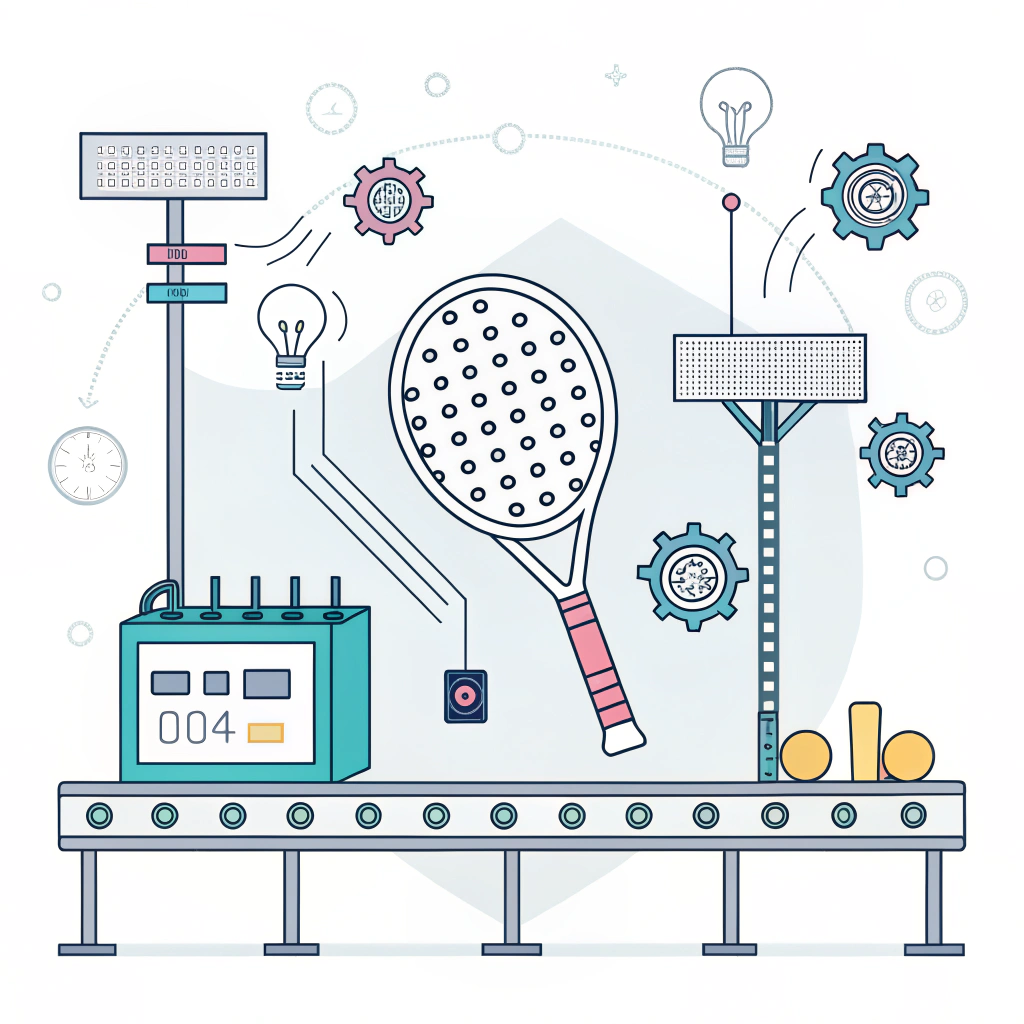In today’s competitive padel equipment market, ensuring a robust quality control1 process is the key to procuring high-performance products that meet strict industry standards. For procurement managers and quality assurance specialists, understanding the nuances behind quality control (QC) in padel racket manufacturing is essential. At NEX Padel, we have developed advanced QC processes that ensure every racket meets precision engineering and durability requirements while complying with regulatory standards2.
Procurement teams face multiple challenges when sourcing padel rackets. The core issues include:
• Maintaining consistent quality across various production batches
• Preventing defects during different stages of manufacturing
• Ensuring material performance, whether it’s glass fiber or high-grade carbon fiber3 (such as 3K, 12K, and 18K)
• Meeting customization requirements in shape and printing details for branded equipment
These challenges are amplified by the need to balance advanced materials with efficient production cycles while ensuring strict adherence to international manufacturing standards. For global B2B sourcing, one misstep in quality can lead to regulatory and performance issues that disrupt market presence.
Penetrating into the manufacturing process reveals several factors that can impair production quality:
- Inconsistent raw material quality: Variability in the performance of materials like carbon fiber can lead to weakened structural integrity.
- Process variability: Differences across production batches cause fluctuations in product performance, sometimes leading to off-spec items.
- Insufficient factory audit protocols: Without continuous monitoring, potential quality issues may not be detected until after shipment.
- Inadequate customization controls: For customized orders, details such as logo placement, hand grip specifications, and color accuracy can be compromised if not strictly monitored.
Such factors drive the need for rigorous quality controls that are systematically implemented throughout the manufacturing process.
At NEX Padel, our QC process is designed to address these challenges by integrating multiple layers of checks, using both traditional methods and advanced technologies. This comprehensive process comprises the following steps:
Before production begins, every batch of raw material is evaluated for consistency. This includes:
- Carbon fiber testing: Evaluating tensile strength and weave consistency for 3K, 12K, and 18K carbon variations.
- Glass fiber assessments: Confirming elasticity and impact resistance.
- Incoming component checks: For customized parts such as hand grips and handle covers, ensuring they meet brand logos and printing specifications.
During production, continuous monitoring allows early detection of defects:
- Automated measurement systems4: Utilizing digital calipers and sensors to verify dimensions.
- Operator inspections: Cross-checking machine-calculated parameters and visual appearance.
- Environmental control: Maintaining stable temperature and humidity levels during curing of composites to ensure structural integrity.
After assembly, each racket undergoes comprehensive quality tests:
- Impact and vibration tests: To ensure that the internal core (typically comprised of EVA foam or foam rubber) adequately absorbs shock and minimizes vibration.
- Dimensional verification: Confirming that the overall size complies with regulations (e.g., the total length not exceeding 45.5 cm, grip length limits, etc.).
- Surface finish evaluation: Checking for consistency in customized printing and color quality, ensuring unique branding is accurately represented.
Before shipment, products are subject to further audits:
- Randomized batch testing: Sampling from different production batches to verify ongoing compliance.
- Regulatory compliance: Ensuring that all specifications, such as the axle alignment, frame integrity, and material testing data, meet national and international standards.
Below is a table summarizing our key QC checkpoints during the padel racket production process:
| QC Stage | Key Checks & Protocols | Critical Metrics |
|---|---|---|
| Raw Material Inspection | Material composition, tensile strength, elasticity tests | Consistency in carbon/glass fiber quality |
| In-Process Inspections | Dimensional accuracy, environmental controls, visual inspection | Dimensional tolerances (< ±0.5mm) |
| Final Product Testing | Impact, vibration, performance testing, customized printing quality check | Impact resistance, aesthetic quality |
| Post-Production Audit | Random batch sampling, regulatory compliance verification, traceability in production | Zero-defect rate, traceability scores |
One cornerstone of our QC process is the implementation of automated digital measurement systems. These systems not only minimize human-error but also provide a detailed digital record of each product’s dimensional characteristics. For procurement chefs who value transparency and traceability, this ensures that every padel racket delivered meets predefined specifications.
Compliance with regulatory standards is non-negotiable. Our quality control methods are aligned with international guidelines for padel equipment. For example, our testing procedures adhere to strict rules regarding the grip length and overall racket dimensions. This ensures that every product not only meets performance benchmarks but also has the necessary certification for global markets.
Customized padel rackets are increasingly in demand by high-end brands looking to differentiate their product lines. However, customization introduces variables into the manufacturing process. At NEX Padel, we have developed specialized protocols to monitor the quality of personalized printing, logo placement, and color matching. This ensures that even fully customized orders maintain the same rigorous QC standards applied to standard models.
Below is an illustrative checklist table used during the customization phase for each order:
| Customization Aspect | Quality Check | Compliance Requirement |
|---|---|---|
| Custom Logo Printing | Logo clarity, color intensity, alignment | Accurate reproduction, brand consistency |
| Hand Grip Customization | Material durability, texture consistency | Verified with sample testing |
| Color Matching | Uniformity across production, exact shade match | Color calibration standards |
For procurement managers in the sports equipment industry, partnering with a supplier that employs thorough quality control means several advantages:
• Enhanced reliability: With a multi-tier QC process, product variability is significantly reduced, ensuring that every padel racket performs consistently across batches.
• Reduced operational risk: Systematic quality checks prevent defects that could lead to customer dissatisfaction or warranty claims.
• Regulatory alignment: Our comprehensive control measures ensure that every product is compliant with international standards, easing market entry for globally distributed brands.
• Transparent supplier evaluation: Detailed QC records and traceability5 mean that procurement managers receive full visibility into the quality status of their purchases.
• Customization assurance: The ability to meet specific branding and functional customization needs further supports premium positioning for your products.
In a recent collaboration with a renowned sports brand, our advanced QC protocols played a pivotal role in meeting the brand’s quality demands. The client required high-performance padel rackets featuring custom templates and precise color matching. By integrating automated measurement systems and frequent in-process audits, we were able to guarantee a near-zero defect rate, bolstering the client’s confidence in our production capabilities. The improved QC metrics directly translated into enhanced market performance and reduced product returns, reinforcing the importance of rigorous quality assurance in competitive environments.
In summary, here are some actionable steps for ensuring quality control in padel racket manufacturing:
- Engage suppliers with transparent and documented QC procedures.
- Ensure that raw material quality is verified before production begins.
- Incorporate both automated and manual in-process inspections.
- Require comprehensive final product testing that includes performance evaluations.
- Verify that suppliers meet or exceed international regulatory standards.
- For customized orders, implement additional controls specific to branding and design requirements.
For any procurement manager or quality assurance specialist, these steps not only safeguard consistency and customer satisfaction but also fortify the supply chain against operational disruptions.
Below is a summary table detailing key action items for implementing robust QC practices:
| Action Item | Description | Expected Outcome |
|---|---|---|
| Supplier Evaluation | Conduct detailed audits and verify all QC processes | Reduced risk and improved supplier trust |
| Raw Material Verification | Test and confirm the quality of all incoming materials | Consistent material performance |
| In-Process Quality Checks | Utilize advanced automation and manual inspections | Immediate defect detection |
| Final Product Testing & Certification | Implement thorough performance and regulatory tests before shipment | Guarantee of compliance and quality |
| Customization-Specific Controls | Set additional standards for personalized products | Assured brand consistency |
In the B2B landscape of sports equipment manufacturing, robust quality control is not merely a process—it is a commitment to excellence. At NEX Padel, our state-of-the-art QC protocols ensure that whether it’s a standard or a fully customized padel racket, every product meets the highest industry benchmarks. Our multi-stage inspection process, rigorous regulatory compliance, and continuous monitoring systems are designed to deliver superior performance, reliability, and customer satisfaction.
By adopting our advanced manufacturing quality assurance strategies, procurement managers can confidently select a supplier that not only meets their technical requirements but also supports consistent supply chain performance. These processes confirm that we do not compromise on quality, allowing our partners to excel in competitive markets with products that truly stand out.
We encourage you to assess your supplier’s QC processes against our outlined best practices and take proactive steps to integrate advanced quality protocols into your procurement strategy. Discover how partnership with experienced manufacturers like NEX Padel can elevate your product quality and safeguard your market reputation.
People Also Ask
Q: What to look for when buying a padel racket?
A: When buying a padel racket, key considerations include the racket’s shape to ensure a comfortable fit, weight to balance power with maneuverability, balance for tailored playstyle, handle size and grip length for comfort, and the materials used, which impact performance and durability.
Q: What is the regulation for padel racquets?
A: Padel racquet regulations stipulate that the racket must consist of a head and grip, with the grip not exceeding 20 cm in length or 50 mm in thickness. Additionally, the combined length of the head and grip should not exceed 45.5 cm, and the face dimensions must comply with specified limits.
Q: What is the inside of a padel racket?
A: The interior of a padel racket typically contains a core made of materials like EVA foam or foam rubber, which is designed to absorb vibrations and enhance the racket’s overall response to impact, ensuring an optimal playing feel.
-
Quality control: Reading this article will provide insights into systematic processes that ensure products meet strict performance and durability standards throughout manufacturing. ↩
-
Regulatory standards: Discover how adherence to international regulatory standards safeguards product quality and market compliance, essential for global B2B operations. ↩
-
Carbon fiber: Explore advanced materials knowledge to understand carbon fiber grading and testing methodologies, which are critical for ensuring product strength and consistency. ↩
-
Automated measurement systems: Click here to learn how digital measurement tools enhance precision and reduce human errors in manufacturing, ensuring component consistency. ↩
-
Traceability: Learn about traceability systems that provide full visibility into production processes and quality records, enabling efficient supplier evaluation and risk management. ↩







